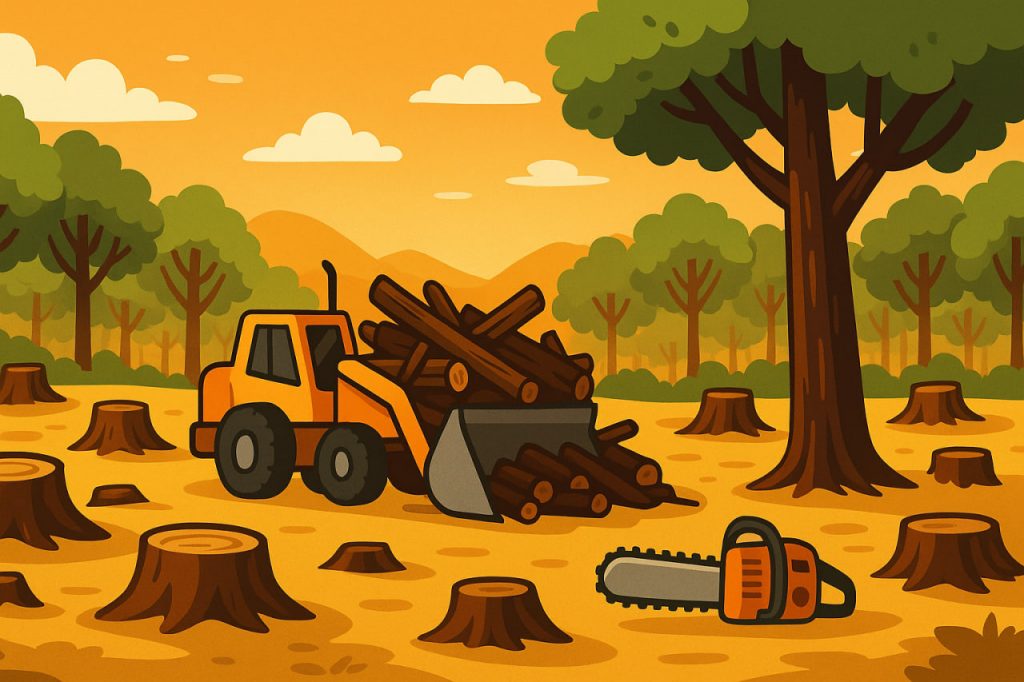Deforestation is the large-scale removal of forests, usually to clear land for agriculture, urban development, or industrial use. While trees are sometimes replanted, the speed and scale of cutting far outpace natural regrowth. Forests cover about 31% of Earth’s land area, but this percentage is shrinking rapidly. Scientists estimate that more than 10 million hectares of forest are lost every year. Deforestation not only reduces biodiversity but also disrupts climate regulation, making it one of the most pressing environmental issues of our time.
Main Causes of Deforestation
Several factors drive deforestation worldwide. Agriculture is the leading cause, as land is cleared for crops like soy and palm oil or for cattle ranching. Logging provides wood for construction, furniture, and paper products. Infrastructure development, such as roads and urban expansion, also contributes to forest loss. In many regions, illegal logging accelerates the problem. Natural disasters like wildfires can worsen the situation, especially when forests already weakened by human activity struggle to recover.
Environmental Consequences
Forests act as vital carbon sinks, absorbing carbon dioxide and slowing climate change. When trees are cut down and burned, the stored carbon is released, increasing greenhouse gas levels. Deforestation also reduces biodiversity, as countless species lose their habitats. Soil becomes more prone to erosion, and water cycles are disrupted, leading to reduced rainfall in some regions. These environmental changes not only affect wildlife but also harm human populations that depend on forests for food, medicine, and clean air.
Social and Economic Effects
Deforestation impacts local communities and economies. Indigenous peoples, who often live in forested areas, lose their homes and cultural heritage. Reduced forest resources affect livelihoods based on hunting, gathering, and small-scale farming. On a global scale, while deforestation may provide short-term economic benefits, such as timber exports, the long-term consequences include climate instability and resource scarcity. This creates a cycle where economic gains are overshadowed by environmental and social losses.
Solutions and Prevention
Preventing deforestation requires global cooperation and sustainable practices. Reforestation and afforestation projects help restore lost forests, though they take decades to mature. Promoting sustainable agriculture, reducing wasteful consumption, and supporting certified wood products can lower demand for destructive logging. Governments play a crucial role by enforcing environmental laws and protecting forests. International agreements, such as the Paris Climate Accord, also encourage countries to preserve forest ecosystems as part of climate action.
Future Outlook
The future of forests depends on immediate action. If current rates of deforestation continue, tropical rainforests like the Amazon could approach a tipping point where they can no longer sustain themselves. This would accelerate climate change and biodiversity loss on a massive scale. However, rising global awareness, advances in satellite monitoring, and community-led conservation projects offer hope. Protecting forests is not only about saving trees but also about preserving the planet’s stability and the well-being of future generations.
Conclusion
Deforestation is a global crisis caused by agriculture, logging, and urban expansion. Its consequences extend far beyond tree loss, affecting biodiversity, climate, and human societies. While challenges remain, sustainable practices and international cooperation can reduce forest destruction. By valuing forests as essential ecosystems rather than disposable resources, humanity can work toward a more balanced relationship with nature.
Glossary
- Deforestation – large-scale removal of forests for human use.
- Forest – an ecosystem dominated by trees and other vegetation.
- Carbon sink – a natural system that absorbs and stores carbon dioxide.
- Biodiversity – the variety of life forms in an ecosystem.
- Reforestation – replanting trees in areas where forests have been cut down.
- Afforestation – planting trees in areas where there were none before.


